When is Each Process Worth It?
In recent years, additive manufacturing processes have evolved rapidly. Prices have dropped significantly due to greater adoption and technical maturity, and the overall technologies have become more refined. What has improved? Tolerances have been significantly reduced, and surfaces have become smoother and more durable. Naturally, with the growing maturity of technology and the increasing experience of young entrepreneurs, costs have decreased, manufacturing times have been reduced, and processes have become more efficient overall. Furthermore, material prices and equipment costs have been reduced. Progress has also been made in control software. 3D printing or injection molding? In this article, we will discuss whether the advancements in 3D printing technology are enough to compete with the established injection molding process.
If you want to produce large quantities of plastic objects (>2,000 pieces), then injection molding is usually the way to go. The significant advantages of injection molding for these large quantities are lower costs, better surface quality, and a generally wider selection of materials. Depending on the desired properties of the objects, the cost advantage of the injection molding process can already come into play in the range of 300-500 pieces.
Case Studies: From Which Quantity Onwards is Injection Molding More Economical?
The parts shown here (from the automotive sector) are to be produced in larger quantities. We compared the option of laser sintering with injection molding (using ABS material). To ensure good comparability, a low surface quality was requested for the injection molding process. The average values from two external providers compared with the laser sintering prices are listed on the left side for each case.
In the next section, we will explain the factors you should consider when selecting the appropriate process for your project.
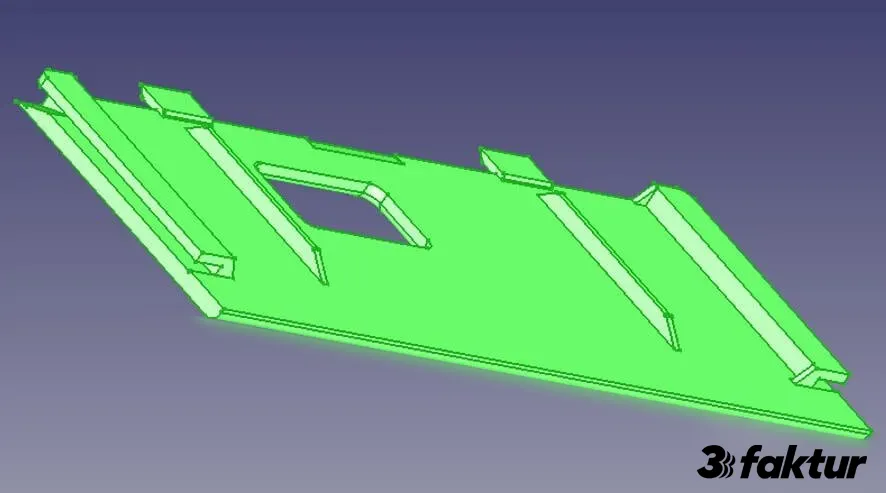
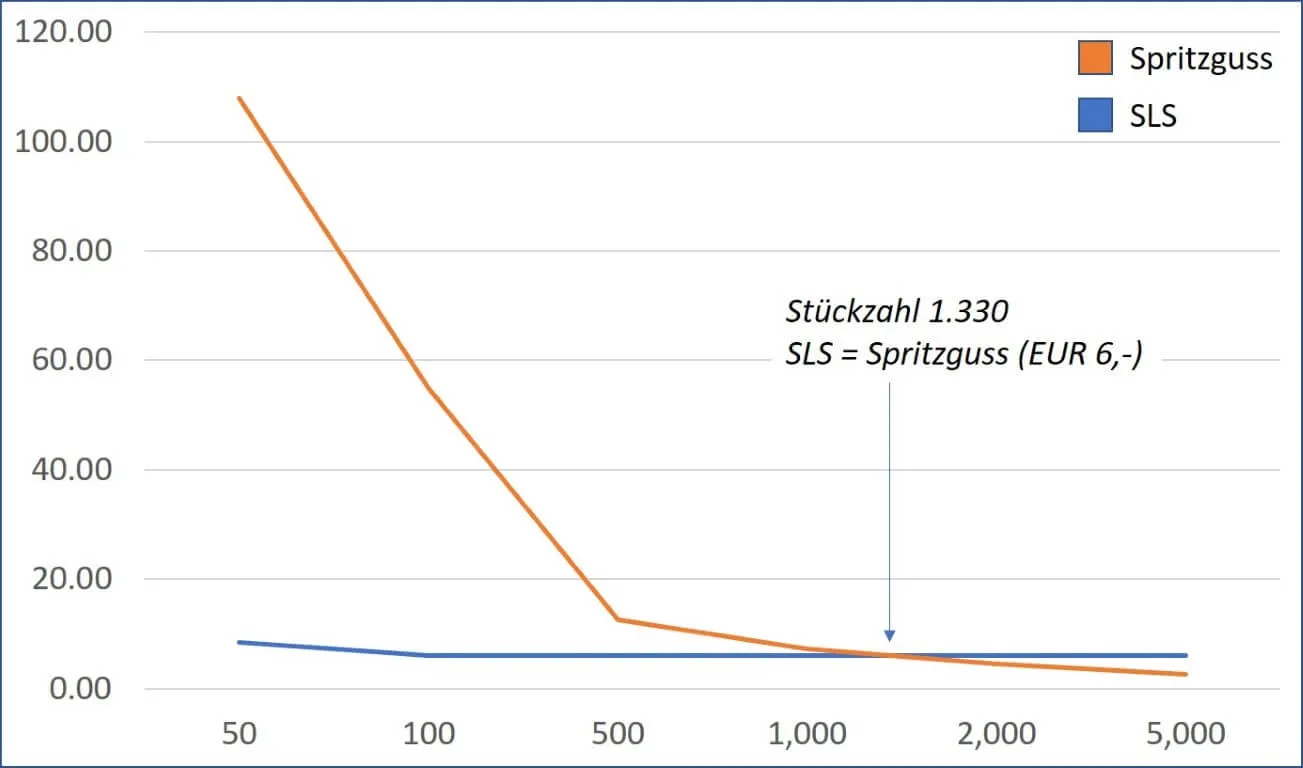
Cover; 129.5 x 52.6 x 5.6 mm. An extreme example, the geometry and size make the part perfect for laser sintering. In most other cases, economically, injection molding is a better option from a quantity of 1,000 pieces onwards.
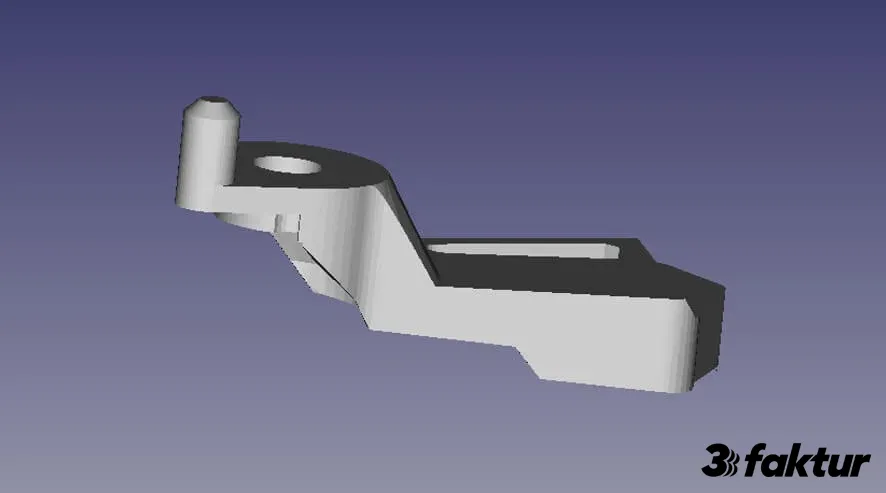
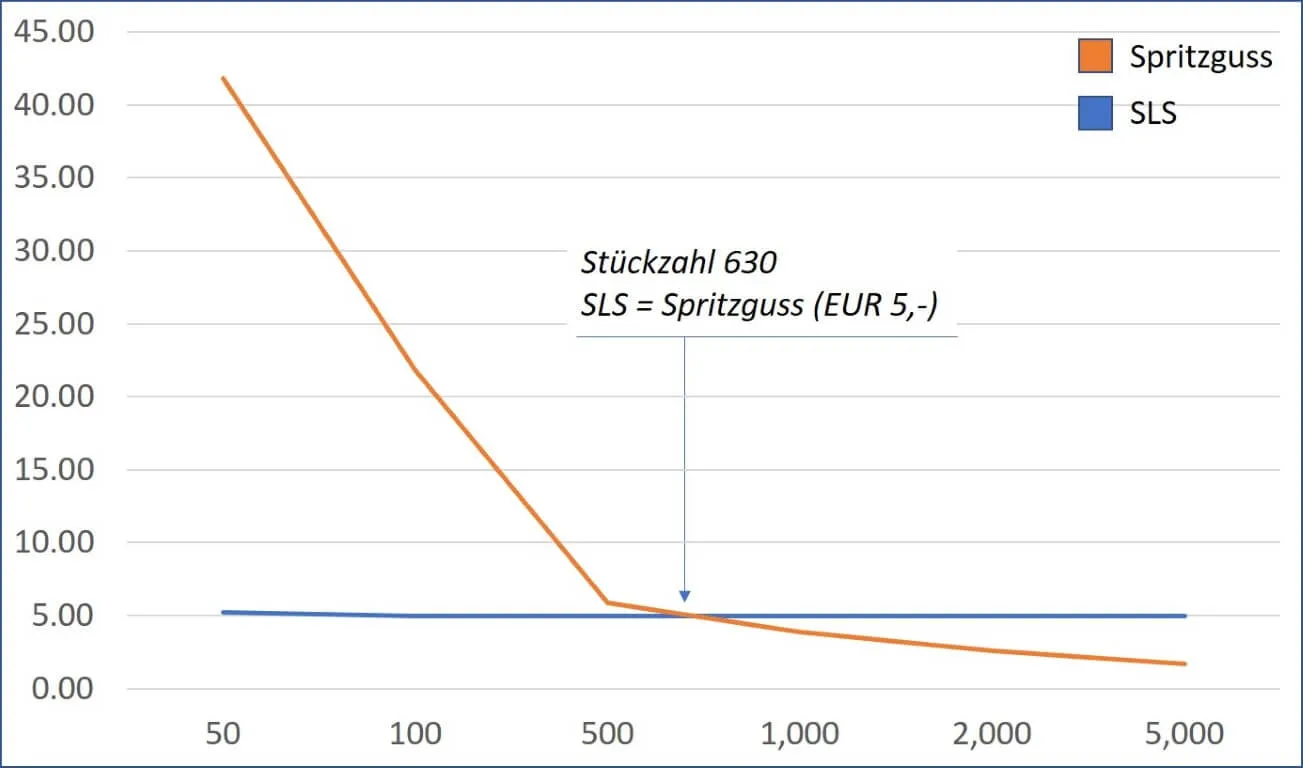
Driver; 43.9 x 18.0 x 20.2 mm
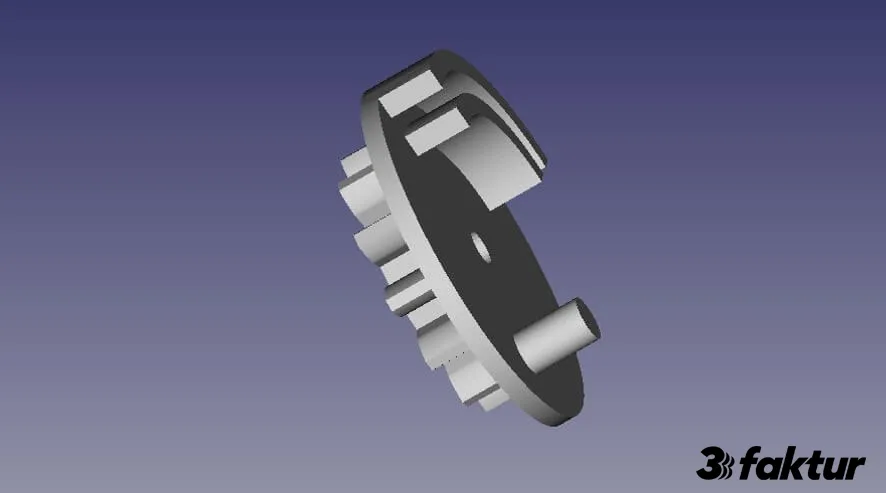
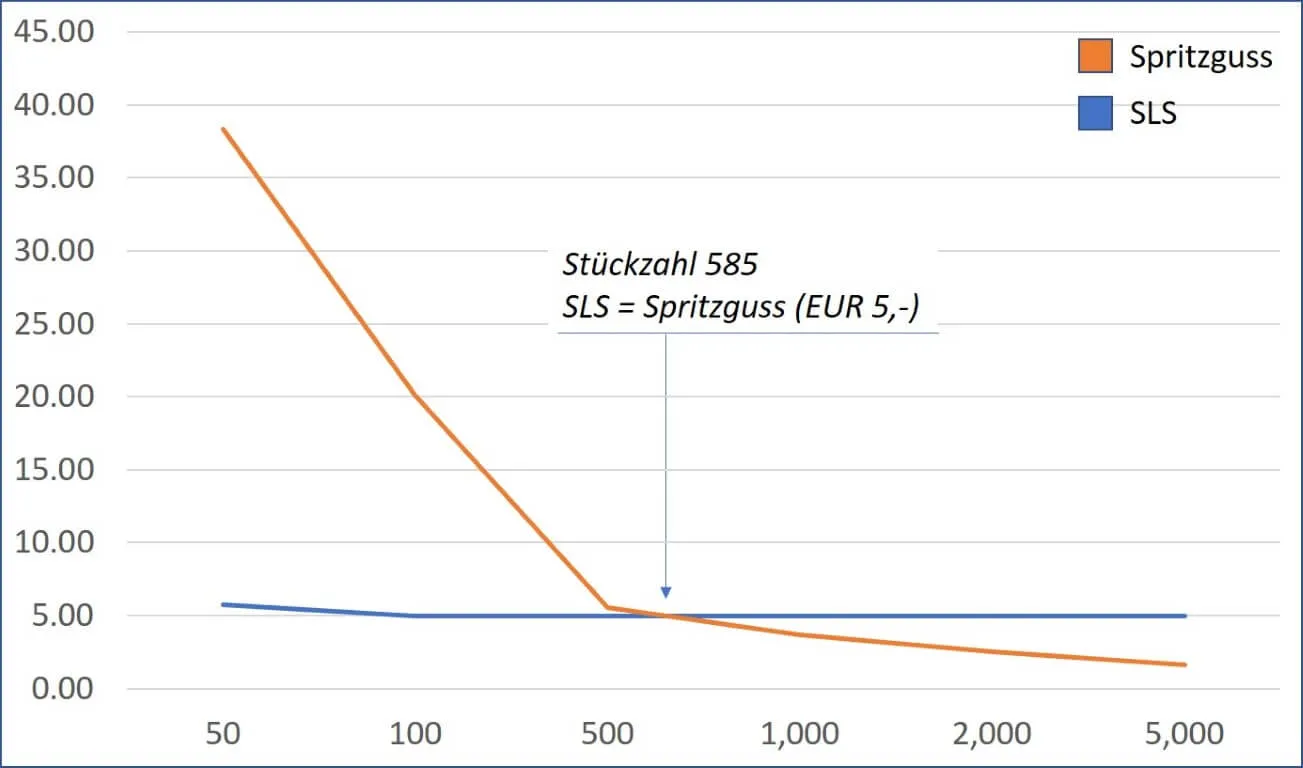
Gear; 15.5 x 15.5 x 6.1 mm
For our comparison study, the average value from two offers from external service providers was used (injection molding ABS with low surface quality). The SLS prices (PA2200) are our own prices. The Y-axis of the graphs represents the unit prices in EUR, and the X-axis represents the quantity.
WHAT FACTORS PLAY A ROLE IN THE DECISION?
This cost advantage can shift in favor of the laser sintering process under certain conditions. If you are planning to produce smaller quantities, i.e. a test series or small series, then you should take the following considerations into account.
- What material properties do you want to achieve?
- What should the surfaces be like?
- What tolerances are acceptable?
- In what quantities are you to produce?
- What are the dimensions of the workpiece?
- Should it still be possible to make changes to the workpiece?
- What time frame do you have for the production of the objects?
The answers to the above questions will determine whether the laser sintering process or the injection molding process is optimal for your project.
MATERIAL OPTIONS
For most small series in 3D printing, the Selective Laser Sintering (SLS) or, more recently, the HP Jet Fusion process is used. In both processes, the material PA12 has become the standard material of choice. PA12 is also utilized in injection molding processes. Sintered PA12 (PA2200) is slightly more porous and lighter (density 0.9 – 0.95 g/cm³) than injection-molded PA12 after production. PA12 from the Jet Fusion process has similar densities as in injection molding.
There are also other materials used for SLS, known as PA12 compounds. These are mixtures of PA12 with other materials to achieve specific properties (e.g., glass fibers for increased thermal resistance, alumina for metallic appearance and rigidity). On the other hand, the material TPU 92 is a thermoplastic elastomer based on urethane. However, the costs for these materials are often higher than for the standard PA12.
Due to the manufacturing process in SLS, the products are slightly anisotropic. This means that the workpieces are more resistant along the X/Y-axis compared to the Z-axis. This is because the Z-axis is the dimension in which the object is built, and the layers in this dimension can separate more easily. This effect is not present in injection molding, where the objects are equally stable in all dimensions.
An alternative to SLS for small series production is Stereolithography (SLA), although this is only applicable to relatively small objects due to the high costs of the process. SLA parts have a smoother surface but are relatively heat-sensitive.
In injection molding, there is a wide variety of materials available with different properties. This allows achieving various physical properties that can meet specific requirements (e.g., fire resistance, chemical resistance, food-grade suitability). By adding pigments or masterbatches, you can freely define the color of your object.
Summary: If the properties of sintered PA12 (PA2200) meet your project requirements, then SLS is an option for your low-volume production; otherwise, injection molding should be considered even for low-volume production.
SURFACES
In the process of selective laser sintering, fine powder particles of the base material are thermally bonded (sintered) together. Due to the nature of the process, the produced workpieces are slightly porous, and their surfaces are somewhat rough without post-processing. Partially automated post-processing methods can help smooth the surfaces to some extent, but they don’t achieve the Ra values (average surface roughness) of injection molding. As mentioned earlier, Stereolithography (SLA) is an option for smoother surfaces, but it comes with the mentioned drawbacks such as lower strength and higher costs.
Depending on the requirements, injection molding can achieve very good surface properties.
Summary: For high surface quality demands in small series production, selective laser sintering is not the first choice. Stereolithography can be an alternative for small, less demanding objects or for smaller quantities (~100).
Tolerances
Selective laser sintering has inherent tolerances of approximately +/- 300 µm or +/- 0.3%. However, these tolerances heavily depend on the objects being printed and can be influenced, for example, by cleverly aligning the object in the printer. In injection molding, there are also tolerances, but experienced mold makers can keep them within a range of 100 µm.
Summary: For very high tolerance requirements, even in smaller quantities, injection molding or other 3D printing methods (e.g., Stereolithography or Polyjet) should be chosen.
Quantities
Based on experience, a rule of thumb has been established: From a quantity of 200 – 500 pieces, injection molding is the most cost-effective method. It is also worthwhile for large or geometrically simple components. For small or complex components, selective laser sintering is cost-effective even for relatively large quantities, as the utilization of the build volume plays a decisive role in 3D printing. For example, doubling the size of the object results in an eight-fold increase in required material or build volume. Therefore, the prices for 3D-printed objects are heavily volume-dependent. This rule has less of an impact on injection molding for object sizes up to approximately 25 cm.
However, when it comes to geometric complexity, selective laser sintering excels. Complexity is almost “free” in this process. Undercuts, cavities, or holes can be easily produced without incurring additional costs. In injection molding, these features often lead to significant cost increases, as additional production steps may be necessary. Consequently, injection molding becomes cost-effective only for higher quantities than usual.
Summary: For small or complex objects, selective laser sintering is the best choice. Injection molding becomes cost-effective at relatively high quantities (>500). For large parts, injection molding can be cost-effective even at relatively low quantities (>50). Typical use cases include pre-series with <100 pieces or small series with low quantities per year.
SIZE/COMPLEXITY OF THE WORKPIECE
As we have discussed, the size/volume of the workpiece is the most significant cost driver in additive manufacturing. Additionally, the build volumes of sintering systems are limited in size. The largest available sintering systems have a build space of approximately 75 cm. However, the most common systems typically have a build space of about 50 cm. When fully utilizing the build space, you can expect a printing time of 24 – 48 hours, making such large objects impractical for small series production using SLS. For an alternative in your small series, you should consider SLS for workpiece sizes up to 25 cm.
The complexity of the object, on the other hand, behaves differently. Injections molded parts with features like passageways, protruding parts, undercuts, cavities, or other intricate components significantly increase costs. It makes the mold-making process more complex and hence more expensive. In 3D printing, this complexity comes “for free,” and only the 3D model’s printability needs to be assessed, with potential post-processing.
Summary: The larger the object (>25 cm), the more suitable injection molding becomes. The more complex your product is, the more cost-effective 3D printing becomes.
ALLOWING FOR CHANGES TO THE WORKPIECE
When using 3D printing technologies in manufacturing, you can easily make design changes by editing the 3D model.
Injection molding does not offer this possibility. For every change, a new mold must be created.
Summary: If you want to keep the option of modifying your workpiece during the pilot/test phase, then additive manufacturing is the right technology for you.
TIMEFRAME
The decision here is relatively straightforward and clear. While the production of molds/tools for injection molding often takes several weeks or even months, using selective laser sintering can provide you with initial workpieces within 48 hours.
Conclusion
In general, 3D printing is much faster than injection molding since the time-consuming process of manufacturing molds/tools is eliminated. Furthermore, making short-term changes to the product (by editing the 3D model) is easily possible. However, as the objects get larger or the accepted tolerance becomes smaller, injection molding becomes the better option. For quantities of >1,000 pieces, injection molding is usually the more cost-effective method. Despite the versatility of 3D printing material like PA12, injection molding offers a huge selection of highly specialized materials.
3D printing is, therefore, worthwhile when you need relatively small quantities and may still need to make some changes. All of this can be done in a very short time. Typical use cases would be test series or pre-series of a product. 3D printing is also a good alternative to injection molding for B. Other applications include the production of specialized medical devices or “hidden” functional parts where surface texture is not critical.
The question of whether to choose 3D printing or injection molding cannot always be answered definitively. However, with the above article, you have a tool that can make the decision easier for you.
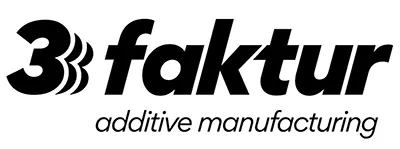
About 3Faktur: 3Faktur specializes in 3D printing, rapid prototyping, and rapid manufacturing. We utilize HP’s Multi Jet Fusion technology and offer various materials for prototyping and series production. If you have any questions about your project, feel free to contact us.
